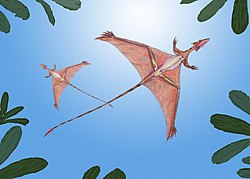| Sharovipteryx Temporal range: Middle Triassic-Late Triassic, | |
|---|---|
 | |
| Cast of the holotype specimen | |
| Scientific classification | |
| Kingdom: | Animalia |
| Phylum: | Chordata |
| Class: | Reptilia |
| Family: | † Sharovipterygidae |
| Genus: | † Sharovipteryx Cowen, 1981 |
| Type species | |
| †Sharovipteryx mirabilis (Sharov, 1971) | |
| Synonyms | |
| |
Sharovipteryx ("Sharov's wing", known until 1981 as Podopteryx, "foot wing") is a genus of early gliding reptiles containing the single species Sharovipteryx mirabilis. It is known from a single fossil and is the only glider with a membrane surrounding the pelvis instead of the pectoral girdle. This lizard-like reptile was found in 1965 in the Madygen Formation, Dzailauchou, on the southwest edge of the Fergana Valley in Kyrgyzstan, in what was then the Asian part of the U.S.S.R. [1] dating to the middle-late Triassic period (about 225 million years ago). The Madygen horizon displays flora that put it in the Upper Triassic. [1] Another unusual reptile, Longisquama, was also found there.
Contents
S. mirabilis is known from a unique holotype specimen, which was first described by Aleksandr Grigorevich Sharov in 1971. [2] Sharov named the species Podopteryx mirabilis, "foot wing", for the wing membranes on the hind limbs. However, that name had previously been used for a genus of damselfly, Podopteryx , so in 1981 Richard Cowen [3] created the new genus name Sharovipteryx for the species.





